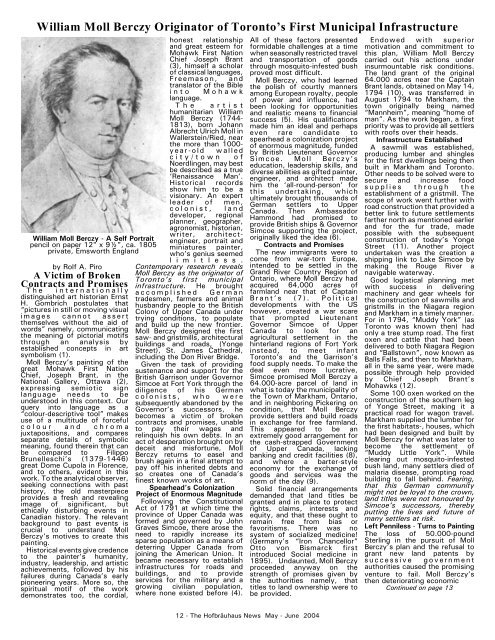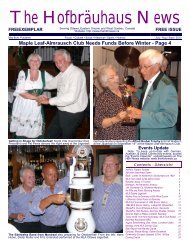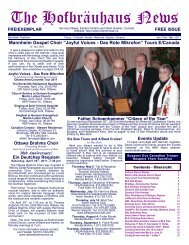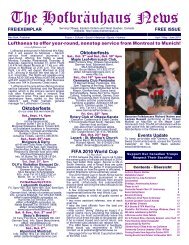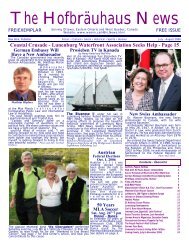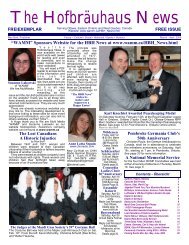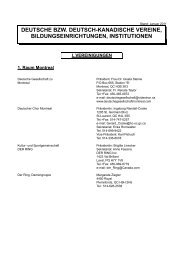Create successful ePaper yourself
Turn your PDF publications into a flip-book with our unique Google optimized e-Paper software.
William Moll Berczy Originator of Toronto’s First Municipal Infrastructure<br />
William Moll Berczy - A Self Portrait<br />
pencil on paper 12" x 9½", ca. 1805<br />
private, Emsworth England<br />
by Rolf A. Piro<br />
A Victim of Broken<br />
Contracts and Promises<br />
<strong>The</strong> internationally<br />
distinguished art historian Ernst<br />
H. Gombrich postulates that<br />
“pictures in still or moving visual<br />
images cannot assert<br />
themselves without the aid of<br />
words” namely, communicating<br />
the meaning of pictorial motifs<br />
through an analysis by<br />
established concepts in art<br />
symbolism (1).<br />
Moll Berczy’s painting of the<br />
great Mohawk First Nation<br />
Chief, Joseph Brant, in the<br />
National Gallery, Ottawa (2),<br />
expressing semiotic sign<br />
language needs to be<br />
understood in this context. Our<br />
query into language as a<br />
“colour-descriptive tool” makes<br />
use of a multitude of forceful<br />
colour and chroma<br />
juxtapositions, and compares<br />
separate details of symbolic<br />
meaning, found therein that can<br />
be compared to Filippo<br />
Brunelleschi’s (1379-1446)<br />
great Dome Cupola in Florence,<br />
and to others, evident in this<br />
work. To the analytical observer,<br />
seeking connections with past<br />
history, the old masterpiece<br />
provides a fresh and revealing<br />
image of significant, but<br />
ethically disturbing events in<br />
Canadian history. <strong>The</strong> relevant<br />
background to past events is<br />
crucial to understand Moll<br />
Berczy’s motives to create this<br />
painting.<br />
Historical events give credence<br />
to the painter’s humanity,<br />
industry, leadership, and artistic<br />
achievements, followed by his<br />
failures during Canada’s early<br />
pioneering years. More so, the<br />
spiritual motif of the work<br />
demonstrates too, the cordial,<br />
honest relationship<br />
and great esteem for<br />
Mohawk First Nation<br />
Chief Joseph Brant<br />
(3), himself a scholar<br />
of classical languages,<br />
Freemason, and<br />
translator of the Bible<br />
into Mohawk<br />
language.<br />
<strong>The</strong> artist<br />
humanitarian William<br />
Moll Berczy (1744-<br />
1813), born Johann<br />
Albrecht Ulrich Moll in<br />
Wallerstein/Ried, near<br />
the more than 1000year-old<br />
walled<br />
city/town of<br />
Noerdlingen, may best<br />
be described as a true<br />
‘Renaissance Man’.<br />
Historical records<br />
show him to be a<br />
visionary. An expert<br />
leader of men,<br />
colonist, land<br />
developer, regional<br />
planner, geographer,<br />
agronomist, historian,<br />
writer, architectengineer,<br />
portrait and<br />
miniatures painter,<br />
who’s genius seemed<br />
l i m i t l e s s .<br />
Contemporary research reveals<br />
Moll Berczy as the originator of<br />
Toronto’s first municipal<br />
infrastructure. He brought<br />
accomplished German<br />
tradesmen, farmers and animal<br />
husbandry people to the British<br />
Colony of Upper Canada under<br />
trying conditions, to populate<br />
and build up the new frontier.<br />
Moll Berczy designed the first<br />
saw- and gristmills, architectural<br />
buildings and roads, (Yonge<br />
Street), St. James Cathedral,<br />
including the Don River Bridge.<br />
Given the task of providing<br />
sustenance and support for the<br />
British Garrison under Governor<br />
Simcoe at Fort York through the<br />
diligence of his German<br />
colonists, who were<br />
subsequently abandoned by the<br />
Governor’s successors, he<br />
becomes a victim of broken<br />
contracts and promises, unable<br />
to pay their wages and<br />
relinquish his own debts. In an<br />
act of desperation brought on by<br />
deceit and misfortune, Moll<br />
Berczy returns to easel and<br />
brush again in a final attempt to<br />
pay off his inherited debts and<br />
so creates one of Canada’s<br />
finest known works of art.<br />
Spearhead’s Colonization<br />
Project of Enormous Magnitude<br />
Following the Constitutional<br />
Act of 1791 at which time the<br />
province of Upper Canada was<br />
formed and governed by John<br />
Graves Simcoe, there arose the<br />
need to rapidly increase its<br />
sparse population as a means of<br />
deterring Upper Canada from<br />
joining the American Union. It<br />
became necessary to establish<br />
infrastructures for roads and<br />
buildings, and to provide<br />
services for the military and a<br />
growing civilian population,<br />
where none existed before (4).<br />
All of these factors presented<br />
formidable challenges at a time<br />
when seasonally restricted travel<br />
and transportation of goods<br />
through mosquito-infested bush<br />
proved most difficult.<br />
Moll Berczy, who had learned<br />
the polish of courtly manners<br />
among European royalty, people<br />
of power and influence, had<br />
been looking for opportunities<br />
and realistic means to financial<br />
success (5). His qualifications<br />
made him an ideal and perhaps<br />
even rare candidate to<br />
spearhead a colonization project<br />
of enormous magnitude, funded<br />
by British Lieutenant Governor<br />
Simcoe. Moll Berczy’s<br />
education, leadership skills, and<br />
diverse abilities as gifted painter,<br />
engineer, and architect made<br />
him the ‘all-round-person’ for<br />
this undertaking, which<br />
ultimately brought thousands of<br />
German settlers to Upper<br />
Canada. <strong>The</strong>n Ambassador<br />
Hammond had promised to<br />
provide British ships & Governor<br />
Simcoe supporting the project,<br />
originally liked the idea (6).<br />
Contracts and Promises<br />
<strong>The</strong> new immigrants were to<br />
come from war-torn Europe,<br />
intended to be settled in the<br />
Grand River Country Region of<br />
Ontario, where Moll Berczy had<br />
acquired 64,000 acres of<br />
farmland near that of Captain<br />
Brant’s (7). Political<br />
developments with the US<br />
however, created a war scare<br />
that prompted Lieutenant<br />
Governor Simcoe of Upper<br />
Canada to look for an<br />
agricultural settlement in the<br />
hinterland regions of Fort York<br />
instead, to meet infant<br />
Toronto’s and the Garrison’s<br />
food supply needs. To make the<br />
deal even more lucrative,<br />
Simcoe promised Moll Berczy a<br />
64.000-acre parcel of land in<br />
what is today the municipality of<br />
the Town of Markham, Ontario,<br />
and in neighboring Pickering on<br />
condition, that Moll Berczy<br />
provide settlers and build roads<br />
in exchange for free farmland.<br />
This appeared to be an<br />
extremely good arrangement for<br />
the cash-strapped Government<br />
of Upper Canada, lacking<br />
banking and credit facilities (8),<br />
and where a barter-style<br />
economy for the exchange of<br />
goods and services was the<br />
norm of the day (9).<br />
Solid financial arrangements<br />
demanded that land titles be<br />
granted and in place to protect<br />
rights, claims, interests and<br />
equity, and that these ought to<br />
remain free from bias or<br />
favoritisms. <strong>The</strong>re was no<br />
system of socialized medicine!<br />
(Germany’s “Iron Chancellor”<br />
Otto von Bismarck first<br />
introduced Social medicine in<br />
1895). Undaunted, Moll Berczy<br />
proceeded anyway on the<br />
strength of promises given by<br />
the authorities namely, that<br />
titles to land ownership were to<br />
be provided.<br />
12 - <strong>The</strong> <strong>Hofbräuhaus</strong> <strong>News</strong> May - June 2004<br />
Endowed with superior<br />
motivation and commitment to<br />
this plan, William Moll Berczy<br />
carried out his actions under<br />
insurmountable risk conditions.<br />
<strong>The</strong> land grant of the original<br />
64.000 acres near the Captain<br />
Brant lands, obtained on May 14,<br />
1794 (10), was transferred in<br />
August 1794 to Markham, the<br />
town originally being named<br />
“Mannheim”, meaning “home of<br />
man”. As the work began, a first<br />
priority was to provide all settlers<br />
with roofs over their heads.<br />
Infrastructure Established<br />
A sawmill was established,<br />
producing lumber and shingles<br />
for the first dwellings being then<br />
built in Markham and Toronto.<br />
Other needs to be solved were to<br />
secure and increase food<br />
supplies through the<br />
establishment of a gristmill. <strong>The</strong><br />
scope of work went further with<br />
road construction that provided a<br />
better link to future settlements<br />
farther north as mentioned earlier<br />
and for the fur trade, made<br />
possible with the subsequent<br />
construction of today’s Yonge<br />
Street (11). Another project<br />
undertaken was the creation a<br />
shipping link to Lake Simcoe by<br />
making the Rouge River a<br />
navigable waterway.<br />
Good logistical planning met<br />
with success in delivering<br />
machinery and gear wheels for<br />
the construction of sawmills and<br />
gristmills in the Niagara region<br />
and Markham in a timely manner.<br />
For in 1794, “Muddy York” (as<br />
Toronto was known then) had<br />
only a tree stump road. <strong>The</strong> first<br />
oxen and cattle that had been<br />
delivered to both Niagara Region<br />
and “Ballstown”, now known as<br />
Balls Falls, and then to Markham,<br />
all in the same year, were made<br />
possible through help provided<br />
by Chief Joseph Brant’s<br />
Mohawks (12).<br />
Some 100 oxen worked on the<br />
construction of the southern leg<br />
of Yonge Street, making it a<br />
practical road for wagon travel.<br />
Markham supplied the lumber for<br />
the first habitats-, houses, which<br />
had been designed and built by<br />
Moll Berczy for what was later to<br />
become the settlement of<br />
“Muddy Little York”. While<br />
clearing out mosquito-infested<br />
bush land, many settlers died of<br />
malaria disease, prompting road<br />
building to fall behind. Fearing,<br />
that this German community<br />
might not be loyal to the crown,<br />
land titles were not honoured by<br />
Simcoe’s successors, thereby<br />
putting the lives and future of<br />
many settlers at risk.<br />
Left Penniless - Turns to Painting<br />
<strong>The</strong> loss of 50.000-pound<br />
Sterling in the pursuit of Moll<br />
Berczy’s plan and the refusal to<br />
grant new land patents by<br />
successive government<br />
authorities caused the promising<br />
venture to fail. Moll Berczy’s<br />
then deteriorating economic<br />
Continued on page 13


